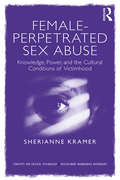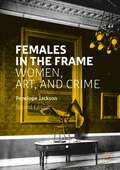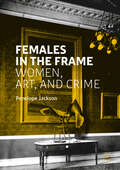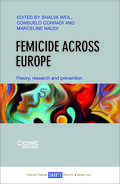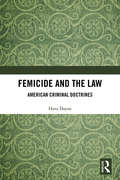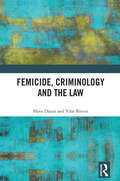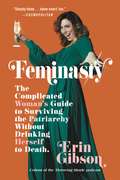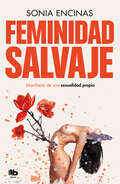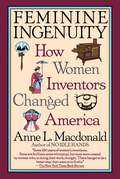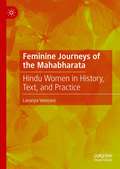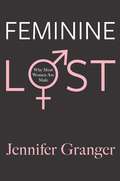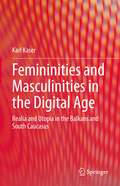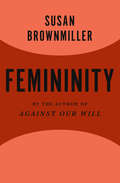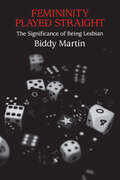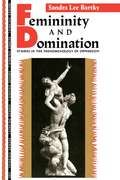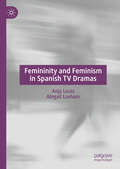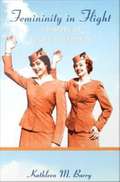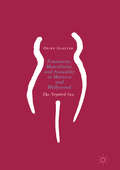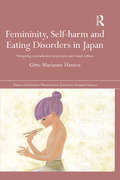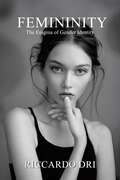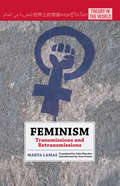- Table View
- List View
Female-Perpetrated Sex Abuse: Knowledge, Power, and the Cultural Conditions of Victimhood (Concepts for Critical Psychology)
by Sherianne KramerFemale-Perpetrated Sex Abuse is a groundbreaking study into gender, sexuality and victimhood. It examines the cultural conditions of possibility for FSA victimhood as a means to advance contemporary critical understandings of the role of gender and sexuality as instruments of modern power. As the first direct exploration of FSA victimhood, this book analyses: why victims of FSA remain so underexplored and invisible as objects of human science knowledge; the limited and overly rigid discourses in local and global psychological theory and practice that continues to treat particular subjects as ‘victim worthy’ through paradigms that construct victimhood as gendered; and the possibility of new discourses that could disrupt normative understandings of gender, sexuality, and power in sex abuse, and as constitutive to the beginnings of a counter-knowledge on transgressive sexualities. By tracing the historical and cultural conditions of the emergence of FSA broadly and FSA victimhood specifically, Kramer illustrates how deeply engrained constructions of gender and sexuality both produce and constrain the possibilities for reporting, disclosing and self-identifying victimhood. Female-Perpetrated Sex Abuse is essential reading for academics, researchers and students alike, in the areas of psychology, sociology, gender studies, criminology, counselling and social work.
Females in the Frame: Women, Art, and Crime
by Penelope JacksonThis book explores the untold history of women, art, and crime. It has long been widely accepted that women have not played an active role in the art crime world, or if they have, it has been the part of the victim or peacemaker. Women, Art, and Crime overturns this understanding, as it investigates the female criminals who have destroyed, vandalised, stolen, and forged art, as well as those who have conned clients and committed white-collar crimes in their professional occupations in museums, libraries, and galleries. Whether prompted by a desire for revenge, for money, the instinct to protect a loved one, or simply as an act of quality control, this book delves into the various motivations and circumstances of women art criminals from a wide range of countries, including the UK, the USA, New Zealand, Romania, Germany, and France. Through a consideration of how we have come to perceive art crime and the gendered language associated with its documentation, this pioneering study questions why women have been left out of the discourse to date and how, by looking specifically at women, we can gain a more complete picture of art crime history.
Females in the Frame: Women, Art, and Crime
by Penelope JacksonThis book explores the untold history of women, art, and crime. It has long been widely accepted that women have not played an active role in the art crime world, or if they have, it has been the part of the victim or peacemaker. Women, Art, and Crime overturns this understanding, as it investigates the female criminals who have destroyed, vandalised, stolen, and forged art, as well as those who have conned clients and committed white-collar crimes in their professional occupations in museums, libraries, and galleries. Whether prompted by a desire for revenge, for money, the instinct to protect a loved one, or simply as an act of quality control, this book delves into the various motivations and circumstances of women art criminals from a wide range of countries, including the UK, the USA, New Zealand, Romania, Germany, and France. Through a consideration of how we have come to perceive art crime and the gendered language associated with its documentation, this pioneering study questions why women have been left out of the discourse to date and how, by looking specifically at women, we can gain a more complete picture of art crime history.
Females: A Concern
by Andrea Long ChuAn exploration of gender and desire from our most exciting new public intellectual &“Everyone is female, and everyone hates it.&” So begins Andrea Long Chu&’s genre-defying investigation into sex and lies, desperate artists and reckless politics, the smothering embrace of gender and the punishing force of desire. Drawing inspiration from a forgotten play by Valerie Solanas—the woman who wrote the SCUM Manifesto and shot Andy Warhol—Chu aims her searing wit and surgical intuition at targets ranging from performance art to psychoanalysis, incels to porn, and even feminists like herself. Each step of the way she defends the indefensible claim that femaleness is less a biological state of women and more a fatal existential condition that afflicts the entire human race—men, women, and everyone else. Or maybe she&’s just projecting. A thrilling new voice who has been credited with launching the &“second wave&” of trans studies, Chu shows readers how to write for your life, baring herself with a morbid sense of humor and a mordant kind of hope.
Femicide across Europe: Theory, Research and Prevention
by Shalva Weil, Consuelo Corradi and Marceline NaudiAvailable Open Access under CC-BY-NC licence. Femicide, the killing of women and girls because of their gender, was until recently included in the category ‘homicide’, obscuring the special features of this social and gendered phenomenon. However, the majority of murders of women are perpetrated by men whom they know from family ties and are the result of intimate partner violence or so-called 'honour' killings. This book is the first one on femicide in Europe and presents the findings of a four-year project discussing various aspects of femicide. Written by leading international scholars with an interdiscplinary perspective, it looks at the prevention programmes and comparative quantitative and qualitative data collection, as well as the impact of culture. It proposes the establishment of a European Observatory on Femicide as a new direction for the future, showing the benefits of cross-national collaboration, united to prevent the murder of women and girls.
Femicide and the Law: American Criminal Doctrines
by Hava DayanThis book explores femicide, and scrutinizes the three key American criminal doctrines usually applied in its cases: provocation; the felony murder rule; self-defence. The book also explores the influence of the American Model Penal Code, and proposes, connected to the various criminal doctrines applicable to femicide, a focused and detailed amendment to the Code containing unique features and a formula providing a socio-legal response to issues that the author believes have not yet been adequately addressed. Though primarily focused on femicide in America, the issues discussed are of global relevance due to the tragically widespread nature of femicide, and the book also makes significant contributions to the legal discourse of many other countries with similar legal structures.
Femicide, Criminology and the Law
by Hava Dayan Yifat BittonThis book offers an interdisciplinary perspective on femicide, using Israel as an illuminating case study, given its diverse communities and common-law-based legal system. Utilizing analytical alongside practical perspectives, the book offers a novel crimino-legal approach to femicide. In addition to its interdisciplinary novelty, the book presents originality in going beyond the more usual focus on the central victims and the common legal tools. Here, the authors extend the analysis to secondary victims of femicide and examine the applicability of second-tiered relevant legal tools, mostly tort law, as a means for gaining justice for the victims. This explorative journey culminates with the authors’ definition of femicide as a quintessential "crime of distinct nature". In the context of current international pledges to better understand and consequently better fight femicide, this work allows readers to comprehend the phenomenon and the ways to abolish it. The book will be an invaluable resource for academics, researchers and policy makers working in the areas of criminal law, tort law, family law, criminology and gender studies, as well as for legal theorists and criminologists seeking integration of both disciplines.
Feminasty: The Complicated Woman's Guide to Surviving the Patriarchy Without Drinking Herself to Death
by Erin GibsonFrom the wickedly famous and feminist creator and host of the "Throwing Shade" podcast, a collection of hilarious personal essays and political commentary perfect for fans of Lindy West and Roxane Gay. Since women earned the right to vote a little under one hundred years ago, our progress hasn't been the Olympic sprint toward gender equality first wave feminists hoped for, but more of a slow, elderly mall walk (with frequent stops to Cinnabon) over the four hundred million hurdles we still face. Some of these obstacles are obvious-unequal pay, under-representation in government, reproductive restrictions, lack of floor-length mirrors in hotel rooms. But a lot of them are harder to identify. They're the white noise of oppression that we've accepted as lady business as usual, and the patriarchy wants to keep it that way.Erin Gibson has a singular goal-to create a utopian future where women are recognized as humans. In FEMINASTY-titled after her nickname on the hit podcast "Throwing Shade"-she has written a collection of make-you-laugh-until-you-cry essays that expose the hidden rules that make life as a woman unnecessarily hard and deconstructs them in a way that's bold, provocative and hilarious. Whether it's shaming women for having their periods, allowing them into STEM fields but never treating them like they truly belong, or dictating strict rules for how they should dress in every situation, Erin breaks down the organized chaos of old fashioned sexism, intentional and otherwise, that systemically keeps women down.
Feminidad salvaje: Manifiesto de una sexualidad propia
by Sonia Encinas¿Te has preguntado por qué vives la sexualidad como lo haces? ¿Qué significa para ti gozar? Con Feminidad salvaje, la sexóloga Sonia Encinas nos invita a abrir una caja de Pandora que lleva demasiado tiempo enterrada y a unirnos a una revolución que no necesita ni pancartas ni barricadas. Esta tiene lugar en lo más íntimo, en nuestra propia cama, en nuestro propio cuerpo, en nuestros propios ritmos sexuales y en la definición propia de la feminidad. Se trata de una sublevación ante lo que nos dijeron que debíamos ser y de una transformación que nos conecta con nuestra esencia más salvaje, aquello que no podemos (ni debemos) domar. Un camino hacia la mujer sexual que somos. Para recuperarnos, liberarnos y gozar. Sonia Encinas, con su gran habilidad para comunicar, se desnuda ante la lectora y, a través de su propia historia –a la vez tan personaly universal–, la guía para reconectar consigo misma, con su cuerpo, con sus emociones y creencias, para redescubrir sin pudor su propia sexualidad. Un libro que habla sobre el sexo, el amor, las relaciones, el respeto, los cuidados, la sororidad y el feminismo. «Mujer salvaje, que el placer sea tu brújula».
Feminine Endings: Music, Gender, and Sexuality
by Susan McclaryA groundbreaking collection of essays in feminist music criticism, this book addresses problems of gender and sexuality in repertoires ranging from the early seventeenth century to rock and performance art. “. . . this is a major book . . . [McClary’s] achievement borders on the miraculous.” The Village Voice“No one will read these essays without thinking about and hearing music in new and interesting ways. Exciting reading for adventurous students and staid professionals.” Choice“Feminine Endings, a provocative ‘sexual politics’ of Western classical or art music, rocks conservative musicology at its core. No review can do justice to the wealth of ideas and possibilities [McClary’s] book presents. All music-lovers should read it, and cheer.” The Women’s Review of Books"McClary writes with a racy, vigorous, and consistently entertaining style. . . . What she has to say specifically about the music and the text is sharp, accurate, and telling; she hears what takes place musically with unusual sensitivity."-The New York Review of Books
Feminine Figurae: Representations of Gender in Religious Texts by Medieval German Women Writers, 1100-1475 (Studies in Medieval History and Culture #10)
by Rebecca L.R. GarberFirst Published in 2003. Routledge is an imprint of Taylor & Francis, an informa company.
Feminine Ingenuity: Women and Invention in America
by Anne Macdonald"Written with clarity and a lively eye both for detail and for the progress of feminism in the United States."SAN FRANCISCO CHRONICLEIn this fascinating study of American women inventors, historian Anne Macdonald shows how creative, resourceful, and entrepreneurial women helped to shatter the ancient stereotypes of mechanically inept womanhood. In presenting their stories, Anne Macdonald's thorough research in patent archives and her engaging use of period magazine, journals, lectures, records from major fairs and expositions, and interviews, have made her book nothing less than an overall history of the women's movement in America.From the Trade Paperback edition.
Feminine Journeys of the Mahabharata: Hindu Women in History, Text, and Practice
by Lavanya VemsaniThe Mahabharata preserves powerful journeys of women recognized as the feminine divine and the feminine heroic in the larger culture of India. Each journey upholds the unique aspects of women's life. This book analytically examines the narratives of eleven women from the Mahabharata in the historical context as well as in association with religious and cultural practices. Lavanya Vemsani brings together history, myth, religion, and practice to arrive at a comprehensive understanding of the history of Hindu women, as well as their significance within religious Indian culture. Additionally, Vemsani provides important perspective for understanding the enduring legacy of these women in popular culture and modern society.
Feminine Lost: Why Most Women are Male
by Jennifer GrangerFeminine Lost explores the premise that all human beings are constructed of two energies, one masculine and one feminine. With the rise of the feminist movement, many women have migrated to their masculine side, some to the extent of losing access to their feminine side altogether. As a consequence, men have found their way to their feminine side. This process has had huge consequences for relationships between men and women, often leaving them feeling unsatisfied within their relationships or lonely without one. Feminine Lost examines female archetypes - the Andro Woman, the Cougar, the Good Doer, and more - that have come to the fore since the feminist movement, pairing them with their masculine opposite, and looking at how the process of attraction functions under these circumstances. When the feminine principle breaks down, the ramifications are many. Feminine Lost breaks through the misunderstanding of what it means to be feminine; it is not an outward appearance but something far more significant.
Femininities and Masculinities in the Digital Age: Realia and Utopia in the Balkans and South Caucasus
by Karl KaserThis book provides a fresh overview on the debate about the remarkable regression of gender equality in the Balkans and South Caucasus caused by the fall of socialism and by the revitalization of religion in Turkey. Contrary to the prevailing opinion of researchers who state continuous male domination, the book presents strong arguments for an alternative outlook. By contrasting the realia of gender relations with the utopia of new femininities and new masculinities driven by digital visual communication, the book provokingly concludes with the arrival of two utopias: the Marlboro Man – still authoritative but lonely – conquering and refusing family obligations; and with the emergence of a new femininity type – strong and beautiful. As such this book provides a great resource to anthropologists, demographers, sociologists, gender and media researchers and all those interested in feminist issues.
Femininity
by Susan BrownmillerWith intelligence and humor, Susan Brownmiller explores the history and unspoken rules of the burden of &“feminine perfection&” What is femininity? How is it measured? What are its demands? How are women meant to dress, look, think, act, feel, and be, according to the mores of society? Susan Brownmiller offers a witty and often pointed critique of the concept of femininity in contemporary culture and throughout history. She explores the demands placed upon women to fit an established mold, examines female stereotypes, and celebrates the hard-won advances in women&’s lifestyle and attire. At once profound, revolutionary, empowering, and entertaining, Femininity challenges the accepted female norm while appreciating the women throughout history who have courageously broken free of its constraints.
Femininity Played Straight: The Significance of Being Lesbian
by Biddy MartinIn Femininity Played Straight, Biddy Martin traces the changing relations of lesbianism and feminist theory from the late 1970s to the present. These sparkling essays argue for accounts of sexuality, gender and subjectivity that make lesbianism intelligible and important, for lesbians and non-lesbians alike. Moving between theoretical and autobiographical modes, Biddy Martin brings different kinds of writing to bear upon one another. At a theoretical level, her work takes issue with postmodern theory, defending instead the role of psychoanalytic criticism. She argues for the continued validity of critical modes that do not abandon the unconscious in seeking to understand the relation of subjectivity to language. In so doing, she addresses the work of writers, thinkers and activists as varied as Mary Daly, Michel Foucault, Adrienne Rich, Gayle Rubin, Minnie Bruce Pratt, Sigmund Freud, Eve Kosofsky Sedgwick, Audre Lorde, Judith Butler, and Joan Copjec.
Femininity and Domination: Studies in the Phenomenology of Oppression
by Sandra Lee BartkyBartky draws on the experience of daily life to unmask the many disguises by which intimations of inferiority are visited upon women. She critiques both the male bias of current theory and the debilitating dominion held by notions of "proper femininity" over women and their bodies in patriarchal culture.
Femininity and Feminism in Spanish TV Dramas
by Anja Louis Abigail LoxhamRecent social and political events in Spain have prompted a resurgence of feminism in the Spanish public sphere. Popular culture intervenes in these debates, and television does so specifically through the dramas which foreground female stories and female subjects, in many cases redefining and interpreting key moments in the progression of national gender politics. This pioneering study maps these developing concerns onto a selection of TV dramas which centre on feminisms and female identities, and as such are key interlocutors in social change. Our intention is to mainstream Spanish television studies and, in our analysis of its innovative and varied approach to gender politics, to take it out of the ‘interpretative isolation ward’ (Smith 2006). This monograph fills a significant gap in the literature on transnational popular culture; it is ground-breaking in its interdisciplinarity (television, modern languages, gender studies) and is the first of its kind in English.
Femininity in Flight: A History of Flight Attendants
by Kathleen M. Barry"In her new chic outfit, she looks like anything but a stewardess working. But work she does. Hard, too. And you hardly know it. " So read the text of a 1969 newspaper advertisement for Delta Airlines featuring a picture of a brightly smiling blond stewardess striding confidently down the aisle of an airplane cabin to deliver a meal. From the moment the first stewardesses took flight in 1930, flight attendants became glamorous icons of femininity. For decades, airlines hired only young, attractive, unmarried white women. They marketed passenger service aloft as an essentially feminine exercise in exuding charm, looking fabulous, and providing comfort. The actual work that flight attendants did--ensuring passenger safety, assuaging fears, serving food and drinks, all while conforming to airlines' strict rules about appearance--was supposed to appear effortless; the better that stewardesses performed by airline standards, the more hidden were their skills and labor. Yet today flight attendants are acknowledged safety experts; they have their own unions. Gone are the no-marriage rules, the mandates to retire by thirty-two. In Femininity in Flight, Kathleen M. Barry tells the history of flight attendants, tracing the evolution of their glamorized image as ideal women and their activism as trade unionists and feminists. Barry argues that largely because their glamour obscured their labor, flight attendants unionized in the late 1940s and 1950s to demand recognition and respect as workers and self-styled professionals. In the 1960s and 1970s, flight attendants were one of the first groups to take advantage of new laws prohibiting sex discrimination. Their challenges to airlines' restrictive employment policies and exploitive marketing practices (involving skimpy uniforms and provocative slogans such as "fly me") made them high-profile critics of the cultural mystification and economic devaluing of "women's work. " Barry combines attention to the political economy and technology of the airline industry with perceptive readings of popular culture, newspapers, industry publications, and first-person accounts. In so doing, she provides a potent mix of social and cultural history and a major contribution to the history of women's work and working women's activism.
Femininity, Masculinity, and Sexuality in Morocco and Hollywood
by Osire GlacierThis book is the first to formulate an ideology of emancipation for women in Morocco. Beginning with constructs of the body, femininity and masculinity, it analyzes the central role played by the sociopolitical writing of sexuality in creating gender hierarchy. The author focuses on Morocco, while drawing parallels with Hollywood cinema, one of the great producers of femininity and masculinity, and conducts an exhaustive examination of constructs of femininity and masculinity in language, social practices, cultural productions and legal texts. The objectives of this project are tripartite: it exposes the dynamics that devalue women's humanity; it charts the schemas of their sexual, economic and sociopolitical exploitation; and it advances concrete solutions for re-establishing women's human dignity.
Femininity, Self-harm and Eating Disorders in Japan: Navigating contradiction in narrative and visual culture (Nissan Institute/Routledge Japanese Studies)
by Gitte Marianne HansenFrom the 1980s onwards, the incidence of eating disorders and self-harm has increased among Japanese women, who report receiving mixed messages about how to be women. Mirroring this, women’s self-directed violence has increasingly been thematised in diverse Japanese narrative and visual culture. This book examines the relationship between normative femininity and women’s self-directed violence in contemporary Japanese culture. To theoretically define the complexities that constitute normativity, the book develops the concept of ‘contradictive femininity’ and shows how in Japanese culture, women’s paradoxical roles are thematised through three character construction techniques, broadly derived from the doppelgänger motif. It then demonstrates how eating disorders and self-harm are included in normative femininity and suggests that such self-directed violence can be interpreted as coping strategies to overcome feelings of fragmentation related to contradictive femininity. Looking at novels, artwork, manga, anime, TV dramas and news stories, the book analyses both globally well known Japanese culture such as Murakami Haruki’s literary works and Miyazaki Hayao’s animation, as well as culture unavailable to non-Japanese readers. The aim of juxtaposing such diverse narrative and visual culture is to map common storylines and thematisation techniques about normative femininity, self-harm and eating disorders. Furthermore, it shows how women’s private struggles with their own bodies have become public discourse available for consumption as entertainment and lifestyle products. Highly interdisciplinary, it will be of huge interest to students and scholars of Japanese studies, Japanese culture and society and gender and women's studies, as well as to academics and consumers of Japanese literature, manga and animation.
Femininity: The Enigma of Gender Identity
by Riccardo DriIn this thought-provoking book, the author explores the intricate dynamics of gender identity, challenging conventional ideas about what defines being a man or a woman. The narrative underscores the critical distinction between sex—biological differences—
Feminising the Masculine?: Women in Non-traditional Employment (Routledge Revivals)
by Margaret WhittockThis title was first published in 2000: This work aims to provide a comparative and temporal assessment of the position of women in non-traditional employment in Europe, Britain and Northern Ireland. Its second aim is to provide a new perspective on the division of labour in modern Western societies and to critically examine the issues, debates and perspectives which have traditionally dominated portrayals of women and paid employment. The book assesses the potential which women themselves have for transforming existing gender relations, particularly within the structural constraints of the education, training and employment systems. In so doing, it is intended to highlight flaws inherent in much contemporary feminist theorizing, and aims to provide a more satisfactory theoretical framework within which to elaborate and develop its arguments. While related texts have tended to concentrate on stereotypical notions of women and paid employment, this book aims to fill a gap in the literature by scrutinizing the lived experiences of women in non-traditional manual occupations, and relating these to a possible transformation of the existing gender order in Western societies
Feminism
by Marta LamasAdding to the debate on a range of issues, this book presents a critical and deeply personal history of Mexican feminism in the last thirty five years. Drawing from her many years of activism and anthropological scholarship, influential thinker Marta Lamas covers topics such as the political development of the feminist movement, affirmative action in the workplace, conceptual advances in regard to gender, and disagreements among feminists. Here in English for the first time, this work offers invaluable insight into the theoretical and political tensions that have shaped Mexican feminism and the world at large.
